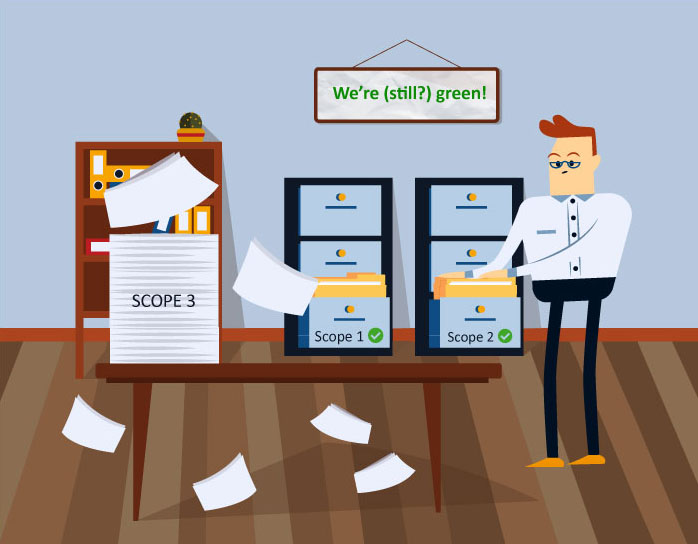
Read. Learn. Act -
Your Go-To Resource for Sustainability Stories
What are Scopes 1, 2, 3, and why is Scope 3 the most important?
Want to know what the GHGP’s different Scopes mean for your company? This article explains all three Scopes – as well as why Scope 3, which deals with supply chain – is the most important, the most overlooked, and how CO2Analysis can help with your Scope 3 carbon footprint.
Starting out – Scopes 1 & 2
Scope 1 is straightforward, it is the emissions made directly by your company, resulting from fuels you consume. This is primarily oil and gas for direct heating, plus petrol and diesel for company vehicles. The impact of burning these fuels generally depends on the efficiency of the thing burning it. You know what systems and vehicles you use and how much fuel of each type is being burned (or if not, can easily find it out). From there you just need to check with the manufacturers, do the maths, and you have your Scope 1.
Scope 2 is use of electricity bought from suppliers. Some time with a spreadsheet and their energy bills is all most people need to work it out.
Most organisations have by now done a very good job of optimising their Scopes 1 and 2. Let’s see what this process looks like.
Meet Joe
Joe heads up the estates department for a large laboratory equipment manufacturer. His employer purchases raw materials and turns them into all the goods their customers need. For many years things have been straightforward, but more recently that’s changing. The company’s customers are trying to become more sustainable, and sales, marketing and operations are all looking to him for answers as they complete tenders. He’s also under pressure from his board of directors, as the shareholders of his quoted company want to know what is being done on sustainability.
Joe has been analysing his scope 1 and 2 emissions for the past 10 years and has made good progress in reducing the company’s emissions in these areas.
He has already purchased newer, more efficient vehicles. They need less fuel to do the same job, so his scope 1 emissions decrease notably. He has upgraded the main sites heating system to one that doesn’t use oil or gas, but instead biomass, a much greener source of energy. Once more his emissions decrease. This all cost quite a bit of money, but it was very effective. He spends £1m and his scope 1 emissions decrease by 70%
Then he moves his focus to scope 2. He switches to a greener energy supplier and just like that he’s cut out his scope 2 emissions.
This is all very good. The board and the team are pleased and Joe can relax, job done.

A few years pass. Once more the pressure is mounting. Sure, the changes they made were good, but the company is being criticised because it still isn’t good enough, and more needs to be done.
Once more Joe looks at his scope 1 and 2. The changes they made before were big and relatively easy. They have even made a few more easy changes and now the company is 75% more efficient in both scope 1 and 2 than they were when Joe first started working on sustainability.
On the flip side, with all those big easy changes made, there isn’t much to work with. He could implement a wide-reaching carbon efficiency project focused on all areas of the business, and works out that would give them roughly another 2% decrease in Scope 1 and 2 emissions. But this change would cost as much as all the previous changes together, for a fraction of the result.
With pressure mounting from customers and internally Joe turns his attention to scope 3.

Let’s take a break from Joe to discuss scope 3. If scope 1 and 2 come from all your direct activities, scope 3 is everything else – the indirect. For most organisations, scope 1 & 2 are about 1-2% of spend and 10-20% of emissions. Scope 3 is the remaining 98% of spend and 80-90% of emissions on average, and for many, it’s far higher. As scopes 1 and 2 are optimized, scope 3 becomes ever larger as a proportion of emissions. It’s not uncommon for a company with good scope 1 and 2 optimization to have 95%+ of their spend and emissions in scope 3.
So what is scope 3?
Scope 3 covers carbon generated from a companies indirect activities. This includes everything a company buys, from pens, paper and coffee mugs to state-of-the-art new equipment. It is also the commuting costs of staff, disposal of waste, transportation and distribution of products, plus pretty much anything anything else that your company buys.
Upstream Scope 3 emissions
- Purchased goods and services
- Capital goods
- Fuel and energy use
- Upstream transport and distribution
- Waste generated in company operations (if you don’t own or control the waste management facilities)
- Business travel
- Employee commuting
- Upstream leased assets
Downstream Scope 3 emissions
- Downstream transport and distribution
- Processing of sold products
- End-use of sold goods and services
- Waste disposal and treatment of products
- Downstream leased assets
- Operation of franchises
- Operation of investment
In short, if you pay someone to do something – supply you, transport items for you, perform a service, etc., the way in which they do that automatically becomes a part of your scope 3. This is actually why Joe came under initial pressure from his customers – they wanted to reduce their scope 3, which means making him reduce his emissions.
Unfortunately, this is a massive job which would normally require a vast amount of man hours, very expensive consultants, and many headaches all around.
Let’s see how Joe’s getting on.
He’s hired a consulting firm who are now going through his data and trying to work out what’s happening with the supply chain information that forms the backbone of his scope 3. They are charging him on a time and materials basis every month and constantly bothering his departments with requests for more information to put into the spreadsheets they spent all their time building. The scale of the task is huge as the company has over 100 million lines of data in their finance and enterprise planning systems.

A year later and they have come up with a plan to improve things and Joe can no longer afford to keep them working.
Joe implements the plan and sees some positive changes in specific areas, but ultimately found the process painful and ineffective. His scope 3 emissions have only marginally reduced and his board are calling it a waste of money.
Joe leaves scope 3 alone for a time. The law doesn’t require he really get to grips with it so he feels safe to do so, and the pressure from customers and shareholders isn’t too intense just yet.
Unfortunately, at least for Joe, the law is steadily changing. Government is changing what is being measured for large quoted companies and as many of Joe’s customers are public sector bodies, he is constantly being asked for more information to put into tenders. Public opinion has also shifted from vague worries about climate change to outright fear and demand over the lack of world progress in this area. This leads to internal friction inside Joe’s company, as many employees want to see tangible change and understand what they can contribute – especially after being poked and prodded for a year by the consultants, for little noticeable gain.1
- SECR stands for Streamlined Energy & Carbon Reporting. It came into effect in April 2019 and all quoted companies in UK, plus any companies deemed large (making over a certain amount of money or having over a number of employees) must report to it and meet its standards. Currently it is mostly focused on scope 1 & 2, but in time it is likely to expand its focus to scope 3 as well. Procurement policy note 06/21: taking account of carbon reduction plans in the procurement of major government contracts, or much more simply; PN 06/21, is a major new procurement notice for those bidding for major government tenders. Anything with a lifetime value over £5m has to be measured and have a plan in place for net zero, which includes the upstream emissions for some of scope 3. From April 2023 the NHS will also be incorporating this, so those who can meet its standards prior to that point will have large benefits. Procurement policy note 06/20: taking account of social value in the award of central government contracts, or again more simply; PN 06/20. This policy paper has a wider scope than that of 06/21, but it hits some similar notes. For public sector tenders and NHS tenders that fall within it, 10% of marks will be given based on sustainability.
Creating a scope 3 Net-Zero plan currently isn’t required by law, but the direction of travel is clear. Increasingly customers are asking for baselined Net Zero plans as part of their tender processes. The early birds as ever will be well placed to catch the worms and the laggards may well have a shock wake up call when they fall foul of PPN 06/21 and find that they can’t bid for a major tender.
Scope 3 also has the potential to save any company money and for those savings to move straight to the bottom line as additional profit. By becoming lean and green and getting everyone in the business aligned with improving processes, using less and removing wastage with a clear path to net-zero, they can improve their bottom line, win more business, retain and attract team members and of course – save the planet. As we’ve discussed, the major difficulty in doing so is the complexity involved in scope 3. In terms of scale, scope 1 and 2 could be considered a few filling cabinets full of paper you need to sort through. Scope 3, on the other hand, is a mountain range of paper.

How C02A can help
At C02A we use groundbreaking AI to do the job of analyzing all the upstream data involved in a company’s scope 3, which is the part they can have the most impact on quickly. Instead of the very lengthy and expensive process Joe attempted by hiring all those consultants, we simply run your data through our AI and it works out everything you need to know. This includes your key suppliers and their carbon impact on your business, the products and services you are buying with the largest carbon footprint, where the bulk of the carbon is being consumed within the organisation and detailed information on individual products and services to underpin carbon reduction initiatives.
In the same way that Joe was able to quickly make some changes resulting in scope 1 and 2 reductions, with our help he could do the same with his scope 3. Even minor progress in scope 3 will have a far bigger effect than anything that can be done in scope 1 and 2, and with detailed information major progress is possible.
Once our AI has been through the data we provide you with a your data analysis and a toolkit that helps you tackle your emissions and track your progress.
Best of all we don’t send any consultants, we charge a fixed fee so there are no surprises and the analysis takes less than a month.

If you’re interested in sorting out your scope 3, schedule a free consultation with us by clicking here.


 +44 (0)118 324 9580
+44 (0)118 324 9580


